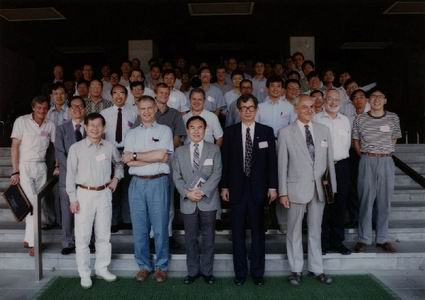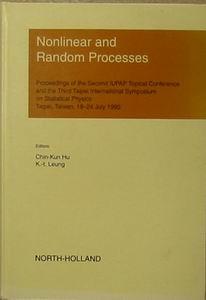

![]()
Conferences ( 1991 1993 1995 1997 1999 2002 2004 2005 2006 2007 2008 2009 ) / Workshops / Seminars and Group Meetings
¡@
StatPhys-Taiwan-1995 Nonlinear and random processes
| ¡@ | ¡@ | ¡@ | ¡@ | ¡@ |
 |
¡@ | |||
| ¡@ | ¡@ | ¡@ | ¡@ | ¡@ |
| ¡@ |
The Second IUPAP Topical Conference and the Third
Taipei International Symposium on Statistical Physics |
¡@ | ||
¡@
| ¡@ |
Preface of the Proceedings |
¡@ | ¡@ | ||
 |
The "Second IUPAP Topical Conference and the Third Taipei International
Symposium on Statistical Physics: Nonlinear and Random Processes"
(StatPhys-Taipei-1995) was held at the Academia Sinica (Taipei) and the
National Taiwan Normal University during 18-24 July 1995. The meeting is
the continuation of previous one. During 1-7 August 1993, the Institute of
Physics of the Academia Sinica (Taipei) hosted the "First IUPAP Topical
Conference and the Second Taipei International Symposium on Statistical
Physics: Order-Disorder Transitions and Criticality"
(StatPhys-Taipei-1993). The proceedings of that meeting were published in
Physica A 205 (1994) 1-485, which describes in its preface the historical
background of this series of meetings. ¡@ This volume contains most invited papers and some contributed papers presented at StatPhys-Taipei-1995 at the Academic Activity Center during 19-22 July and a section on "Teaching Statistical Physics" at the National Taiwan University on 24 July. This conference began with an invited talk presented by Professor Yuan T. Lee, the Nobel laureate of 1986 and the President of Academia Sinica (Taipei), on "Intermolecular Energy Transfer and the Statistical Theory of Unimolecular Dissociation", and ended with invited talks by Professor George Marx and Professor Yih-Yuh Chen. |
¡@ | |||
| ¡@ | ¡@ |
¡@
The StatPhys-Taipei-1995 brought together contributors and participants
from communities of Physical mathematics, chemistry, earth sciences, and
biological sciences. This indicates that the ideas (e.g. fractals,
scaling, universality, relaxation time) and methods (e.g. Monte Carlo
simulations) of statistical physics have been applied to wider and wider
areas of sciences. Among future applications that we have not covered, and
interesting and challenging direction of research is perhaps in areas of
social sciences. In recent decades, more and more countries regardless of
their racial backgrounds or geographical locations have increasingly
respected the freedom of speech and adopted democratic processes to select
their political leaders. This reminds us of the idea of universality in
statistical physics. Fluctuations in voting behavior and their
accumulative effects also bear similarities to fluctuations in physical
system. However, different countries may have different relaxation times
to approach this democratic state. Gladly, since 1992 the Republic of
China in Taiwan has reached the democratic state. Her citizens have
enjoyed a fully democratic political system and freedom of speech; they
will reelect their legislators on 2 December 1995 and President on 23
March 1996 through popular vote. Besides scientific program and city and
museum tours, participants of StatPhys-Taipei-1995 had also enjoyed some
flavor of campaign activities during their stay in Taipei. The outcomes of
elections on 2 December 1995 and 23 March 1996 are hard to predict.
Perhaps, voting behavior is another interesting problem, where statistical
physics might be able to make some contributions. |
¡@ | ||
| ¡@ | ¡@ |
Chin-Kun Hu and K -t. Leung |
|||
¡@
|
|
[Academia Sinica] [Institute of Physics] [Library of the Institute of Physics] [Electronic Journals] [Related Links]
Laboratory of Statistical and Computational Physics